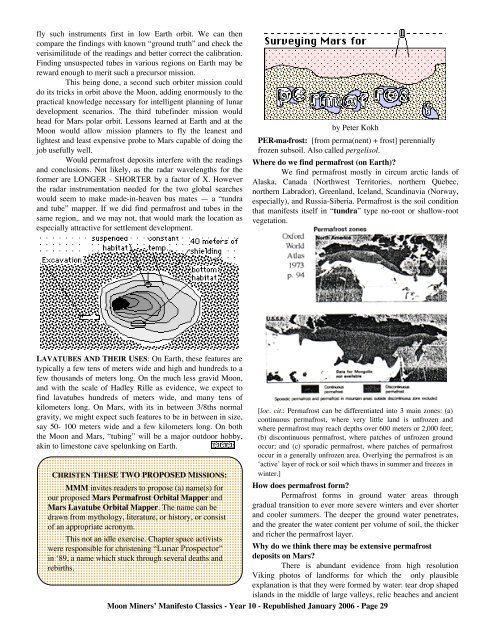MMM Classics Year 10: MMM #s 91-100 - Moon Society
MMM Classics Year 10: MMM #s 91-100 - Moon Society
MMM Classics Year 10: MMM #s 91-100 - Moon Society
Create successful ePaper yourself
Turn your PDF publications into a flip-book with our unique Google optimized e-Paper software.
fly such instruments first in low Earth orbit. We can then<br />
compare the findings with known “ground truth” and check the<br />
verisimilitude of the readings and better correct the calibration.<br />
Finding unsuspected tubes in various regions on Earth may be<br />
reward enough to merit such a precursor mission.<br />
This being done, a second such orbiter mission could<br />
do its tricks in orbit above the <strong>Moon</strong>, adding enormously to the<br />
practical knowledge necessary for intelligent planning of lunar<br />
development scenarios. The third tubefinder mission would<br />
head for Mars polar orbit. Lessons learned at Earth and at the<br />
<strong>Moon</strong> would allow mission planners to fly the leanest and<br />
lightest and least expensive probe to Mars capable of doing the<br />
job usefully well.<br />
Would permafrost deposits interfere with the readings<br />
and conclusions. Not likely, as the radar wavelengths for the<br />
former are LONGER - SHORTER by a factor of X. However<br />
the radar instrumentation needed for the two global searches<br />
would seem to make made-in-heaven bus mates — a “tundra<br />
and tube” mapper. If we did find permafrost and tubes in the<br />
same region,. and we may not, that would mark the location as<br />
especially attractive for settlement development.<br />
LAVATUBES AND THEIR USES: On Earth, these features are<br />
typically a few tens of meters wide and high and hundreds to a<br />
few thousands of meters long. On the much less gravid <strong>Moon</strong>,<br />
and with the scale of Hadley Rille as evidence, we expect to<br />
find lavatubes hundreds of meters wide, and many tens of<br />
kilometers long. On Mars, with its in between 3/8ths normal<br />
gravity, we might expect such features to be in between in size,<br />
say 50- <strong>10</strong>0 meters wide and a few kilometers long. On both<br />
the <strong>Moon</strong> and Mars, “tubing” will be a major outdoor hobby,<br />
akin to limestone cave spelunking on Earth.<br />
CHRISTEN THESE TWO PROPOSED MISSIONS:<br />
<strong>MMM</strong> invites readers to propose (a) name(s) for<br />
our proposed Mars Permafrost Orbital Mapper and<br />
Mars Lavatube Orbital Mapper. The name can be<br />
drawn from mythology, literature, or history, or consist<br />
of an appropriate acronym.<br />
This not an idle exercise. Chapter space activists<br />
were responsible for christening “Lunar Prospector”<br />
in ‘89, a name which stuck through several deaths and<br />
rebirths.<br />
by Peter Kokh<br />
PER•ma•frost: [from perma(nent) + frost] perennially<br />
frozen subsoil. Also called pergelisol.<br />
Where do we find permafrost (on Earth)?<br />
We find permafrost mostly in circum arctic lands of<br />
Alaska, Canada (Northwest Territories, northern Quebec,<br />
northern Labrador), Greenland, Iceland, Scandinavia (Norway,<br />
especially), and Russia-Siberia. Permafrost is the soil condition<br />
that manifests itself in “tundra” type no-root or shallow-root<br />
vegetation.<br />
[loc. cit.: Permafrost can be differentiated into 3 main zones: (a)<br />
continuous permafrost, where very little land is unfrozen and<br />
where permafrost may reach depths over 600 meters or 2,000 feet;<br />
(b) discontinuous permafrost, where patches of unfrozen ground<br />
occur; and (c) sporadic permafrost, where patches of permafrost<br />
occur in a generally unfrozen area. Overlying the permafrost is an<br />
‘active’ layer of rock or soil which thaws in summer and freezes in<br />
winter.]<br />
How does permafrost form?<br />
Permafrost forms in ground water areas through<br />
gradual transition to ever more severe winters and ever shorter<br />
and cooler summers. The deeper the ground water penetrates,<br />
and the greater the water content per volume of soil, the thicker<br />
and richer the permafrost layer.<br />
Why do we think there may be extensive permafrost<br />
deposits on Mars?<br />
There is abundant evidence from high resolution<br />
Viking photos of landforms for which the only plausible<br />
explanation is that they were formed by water: tear drop shaped<br />
islands in the middle of large valleys, relic beaches and ancient<br />
<strong>Moon</strong> Miners’ Manifesto <strong>Classics</strong> - <strong>Year</strong> <strong>10</strong> - Republished January 2006 - Page 29















